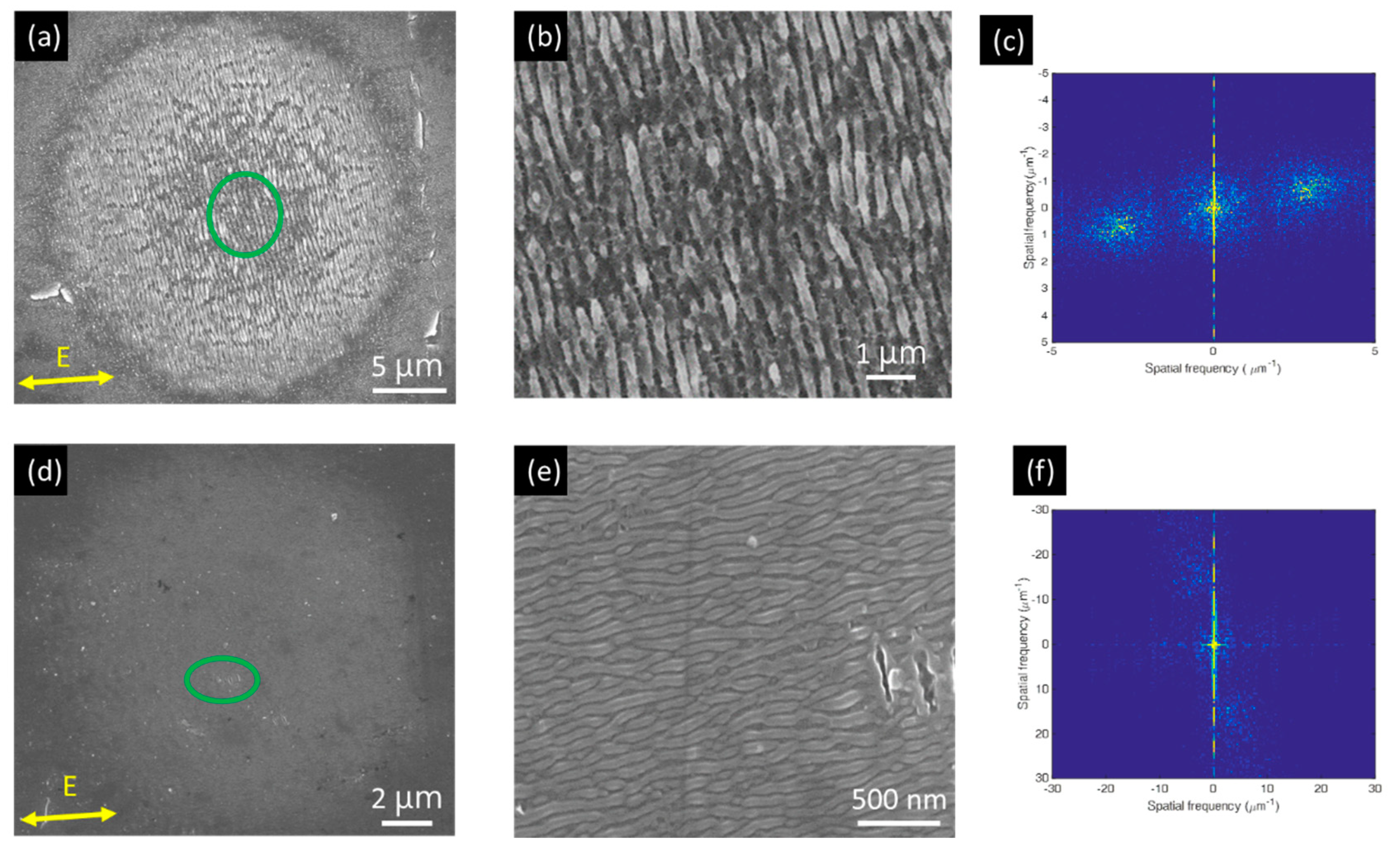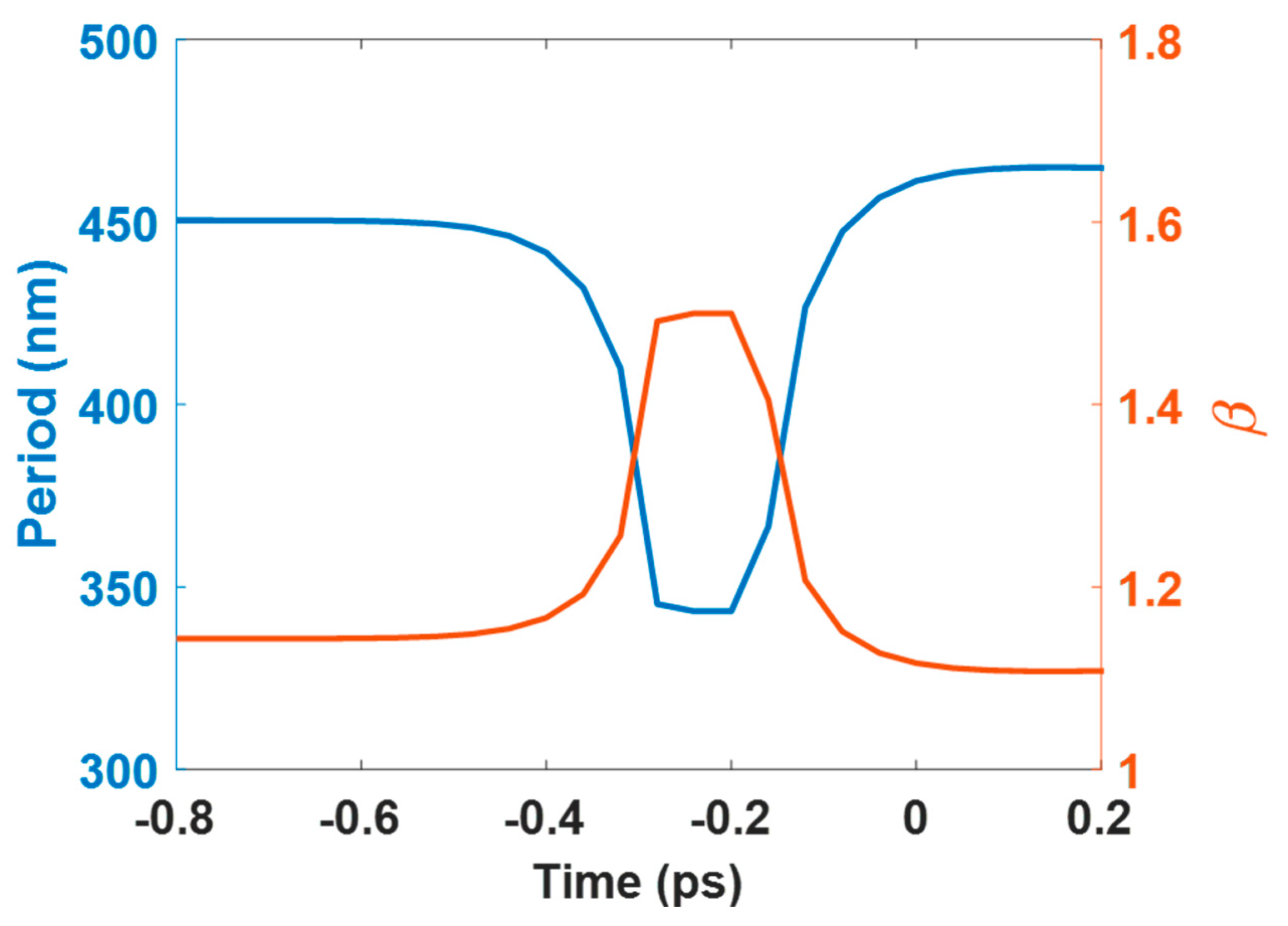Two-Dimensional Periodic Nanostructure Fabricated on Titanium by Femtosecond Green Laser
Abstract
:1. Introduction
2. Materials and Methods
3. Results
3.1. 1D LIPSS Structures
3.2. 2D LIPSS Structures
3.3. EDS Analysis
3.4. Reflectance Analysis
4. Discussion
5. Conclusions
Supplementary Materials
Author Contributions
Funding
Acknowledgments
Conflicts of Interest
References
- Florian, C.; Kirner, S.V.; Krüger, J.; Bonse, J. Surface functionalization by laser-induced periodic surface structures. J. Laser Appl. 2020, 32, 022063. [Google Scholar] [CrossRef]
- Bush, J.R.; Nayak, B.K.; Nair, L.S.; Gupta, M.C.; Laurencin, C.T. Improved bio-implant using ultrafast laser induced self-assembled nanotexture in titanium. J. Biomed. Mater. Res. B 2011, 97, 299–305. [Google Scholar] [CrossRef]
- Shinonaga, T.; Tsukamoto, M.; Kawa, T.; Chen, P.; Nagai, A.; Hanawa, T. Formation of periodic nanostructures using a femtosecond laser to control cell spreading on titanium. Appl. Phys. B 2015, 119, 493–496. [Google Scholar] [CrossRef]
- Orazi, L.; Pelaccia, R.; Mishchenko, O.; Reggiani, B.; Pogorielov, M. Fast LIPSS based texturing process of dental implants with complex geometries. CIRP Annals 2020, 69, 233–236. [Google Scholar] [CrossRef]
- Bonse, J.; Kirner, S.V.; Griepentrog, M.; Spaltmann, D.; Krüger, J. Femtosecond laser texturing of surfaces for tribological applications. Materials 2018, 11, 801. [Google Scholar] [CrossRef] [Green Version]
- Dar, M.H.; Kuladeep, R.; Saikiran, V. Femtosecond laser nanostructuring of titanium metal towards fabrication of low-reflective surfaces over broad wavelength range. Appl. Surf. Sci. 2016, 371, 479–487. [Google Scholar] [CrossRef]
- Tsukamoto, M.; Asuka, K.; Nakano, H.; Hashida, M.; Katto, M.; Abe, N.; Fujita, M. Periodic microstructures produced by femtosecond laser irradiation on titanium plate. Vacuum 2006, 80, 1346–1350. [Google Scholar] [CrossRef]
- Lehr, J.; Kietzig, A.M. Production of homogenous micro-structures by femtosecond laser micro-machining. Opt. Lasers Eng. 2014, 57, 121–129. [Google Scholar] [CrossRef]
- Gemini, L.; Hashida, M.; Nishii, T.; Miyasaka, Y.; Inoue, S.; Limpouch, J.; Mocek, T.; Sakabe, S. Formation of laser induced periodic surface structures (LIPSS) on Ti upon double fs pulse exposure. In Proceedings of the SPIE—The International Society for Optical Engineering, San Francisco, CA, USA, 12 March 2015. [Google Scholar]
- Gnilitskyi, I.; Derrien, T.J.Y.; Levy, Y.; Bulgakova, N.M.; Mocek, T.; Orazi, L. High-speed manufacturing of highly regular femtosecond laser-induced periodic surface structures: Physical origin of regularity. Sci. Rep. 2017, 7, 8485. [Google Scholar] [CrossRef] [Green Version]
- Bonse, J.; Krüger, J.; Höhm, S.; Rosenfeld, A. Femtosecond laser-induced periodic surface structures. J. Laser Appl. 2012, 24, 042006. [Google Scholar] [CrossRef]
- Bonse, J.; Höhm, S.; Rosenfeld, A.; Krueger, J. Sub-100-nm laser-induced periodic surface structures upon irradiation of titanium by Ti: Sapphire femtosecond laser pulses in air. Appl. Phys. A-Mater. 2013, 110, 547–551. [Google Scholar] [CrossRef]
- Kirner, S.V.; Wirth, T.; Sturm, H.; Krüger, J.; Bonse, J. Nanometer-resolved chemical analyses of femtosecond laser-induced periodic surface structures on titanium. J. Appl. Phys. 2017, 122, 104901. [Google Scholar] [CrossRef]
- Li, X.F.; Zhang, C.Y.; Li, H.; Dai, Q.F.; Lan, S.; Tie, S.L. Formation of 100-nm periodic structures on a titanium surface by exploiting the oxidation and third harmonic generation induced by femtosecond laser pulses. Opt. Express 2014, 22, 28086–28099. [Google Scholar] [CrossRef]
- Nathala, C.S.; Ajami, A.; Ionin, A.A.; Kudryashov, S.I.; Makarov, S.V.; Ganz, T.; Assion, A.; Husinsky, W. Experimental study of fs-laser induced sub-100-nm periodic surface structures on titanium. Opt. Express 2015, 23, 5915–5929. [Google Scholar] [CrossRef]
- Hermens, U.; Pothen, M.; Winands, K.; Arntz, K.; Klocke, F. Automated polarization control for the precise alignment of laser-induced self-organized nanostructures. Opt. Lasers Eng. 2018, 101, 44–50. [Google Scholar] [CrossRef]
- Kobayashi, T.; Yan, J. Generating Nanodot Structures on Stainless-Steel Surfaces by Cross Scanning of a Picosecond Pulsed Laser. Nanomanuf. Metrol. 2020, 3, 105–111. [Google Scholar] [CrossRef]
- Saleh, A.A.; Rudenko, A.; Reynaud, S.; Pigeon, F.; Garrelie, F.; Colombier, J.P. Sub-100 nm 2D nanopatterning on a large scale by ultrafast laser energy regulation. Nanoscale 2020, 12, 6609–6616. [Google Scholar] [CrossRef]
- Landis, E.C.; Phillips, K.C.; Mazur, E.; Friend, C.M. Formation of nanostructured TiO2 by femtosecond laser irradiation of titanium in O2. J. Appl. Phys. 2012, 112, 063108. [Google Scholar] [CrossRef]
- Fuentes-Edfuf, Y.; Sánchez-Gil, J.A.; Florian, C.; Giannini, V.; Solis, J.; Siegel, J. Surface plasmon polaritons on rough metal surfaces: Role in the formation of laser-induced periodic surface structures. ACS Omega 2019, 4, 6939–6946. [Google Scholar] [CrossRef]
- Huang, M.; Zhao, F.; Cheng, Y.; Xu, N.; Xu, Z. Origin of Laser-Induced Near-Subwavelength Ripples: Interference between Surface Plasmons and Incident Laser. ACS Nano 2009, 3, 4062–4070. [Google Scholar] [CrossRef]
- Bonch-Bruevich, A.M.; Libenson, M.N.; Makin, V.S.; Trubaev, V.V. Surface electromagnetic waves in optics. Opt. Eng. 1992, 31, 718–730. [Google Scholar] [CrossRef]
- Bévillon, E.; Stoian, R.; Colombier, J.P. Nonequilibrium optical properties of transition metals upon ultrafast electron heating. J. Phys. Condens. Matter. 2018, 30, 385401. [Google Scholar] [CrossRef]
- Winter, J.; Rapp, S.; Schmidt, M.; Huber, H.P. Ultrafast laser processing of copper: A comparative study of experimental and simulated transient optical properties. Appl. Surf. Sci. 2017, 417, 2–15. [Google Scholar] [CrossRef]
- Chang, C.L.; Cheng, C.W.; Chen, J.K. Femtosecond laser-induced periodic surface structures of copper: Experimental and modeling comparison. Appl. Surf. Sci. 2019, 469, 904–910. [Google Scholar] [CrossRef]
- Ionin, A.A.; Kudryashov, S.I.; Makarov, S.V.; Seleznev, L.V.; Sinitsyn, D.V.; Ligachev, A.E.; Golosov, E.V.; Kolobov, Y.R. Sub-100 nanometer transverse gratings written by femtosecond laser pulses on a titanium surface. Laser Phys. Lett. 2013, 10, 056004. [Google Scholar] [CrossRef]
- Höhm, S.; Rosenfeld, A.; Krüger, J.; Bonse, J. Laser-induced periodic surface structures on titanium upon single-and two-color femtosecond double-pulse irradiation. Opt. Express 2015, 23, 25959–25971. [Google Scholar] [CrossRef]








| Sample | Carbon | Oxygen | Ti |
|---|---|---|---|
| Unirradiated | 22 | 0 | 78 |
| 1D-LSFL | 11 | 30 | 59 |
| 1D-HSFL | 21 | 9 | 70 |
| 2D-LSFL | 16 | 34 | 50 |
| 2D-HSFL | 21 | 18 | 61 |
| Wavelength λ (nm) | Type | LIPSS Period (nm) | LIPSS Orientation to E | Fluence (mJ/cm2) | Number of Pulses N | Reference |
|---|---|---|---|---|---|---|
| 1030 | 1D-LSFL | 737 | Perpendicular | 590 | 2 | [10] |
| 800 | 1D-LSFL | 460–665 | Perpendicular | 40–120 | 36 | [15] |
| 790 | 1D-LSFL | 405–800 | Perpendicular | 90–350 | 1–1000 | [12] |
| 515 | 1D-LSFL | 300–360 | Perpendicular | 40 | 125 | This work |
| 400 | 1D-LSFL | 300 | Perpendicular | 48 | 220 | [15] |
| 800 | 1D-HSFL | 50–150 | Parallel | 30–45 | 220 | [15] |
| 790 | 1D-HSFL | 65–95 | Parallel | 50–90 | 50 | [12] |
| 515 | 1D-HSFL | 55–75 | Parallel | 22 | 75 | This work |
| 400 | 1D-HSFL | 50–150 | Parallel | 30–50 | 220 | [15] |
| 515 | 2D-LSFL | 200 | - | 40 + 22 | 125 + 125 | This work |
| 515 | 2D-HSFL | 50–100 | - | 22 + 22 | 75 + 75 | This work |
© 2020 by the authors. Licensee MDPI, Basel, Switzerland. This article is an open access article distributed under the terms and conditions of the Creative Commons Attribution (CC BY) license (http://creativecommons.org/licenses/by/4.0/).
Share and Cite
Liu, Y.-H.; Yeh, S.-C.; Cheng, C.-W. Two-Dimensional Periodic Nanostructure Fabricated on Titanium by Femtosecond Green Laser. Nanomaterials 2020, 10, 1820. https://doi.org/10.3390/nano10091820
Liu Y-H, Yeh S-C, Cheng C-W. Two-Dimensional Periodic Nanostructure Fabricated on Titanium by Femtosecond Green Laser. Nanomaterials. 2020; 10(9):1820. https://doi.org/10.3390/nano10091820
Chicago/Turabian StyleLiu, Yi-Hsien, Shu-Chun Yeh, and Chung-Wei Cheng. 2020. "Two-Dimensional Periodic Nanostructure Fabricated on Titanium by Femtosecond Green Laser" Nanomaterials 10, no. 9: 1820. https://doi.org/10.3390/nano10091820




